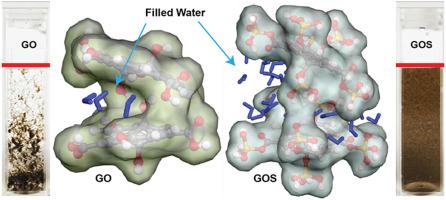Carbon ( IF 10.9 ) Pub Date : 2021-09-02 , DOI: 10.1016/j.carbon.2021.08.089 Junlin Lin 1 , Xupei Yao 1 , Felipe Basquiroto de Souza 1 , Kwesi Sagoe-Crentsil 1 , Wenhui Duan 1

|
Nanoparticle-decorated graphene oxide (NP-GO) nanohybrids hold great promise in a wide range of technologies due to their remarkable synergistic properties. However, a fundamental challenge in the design of NP-GO-based materials is manipulating their dispersion during processing to develop target nano- and microstructures towards the desired performance of the end-products. Herein, we report a combined experimental and molecular dynamic simulation approach to identifying the key underlying mechanisms associated with dispersion of nanohybrids in aqueous solutions, adopting 2D nanosilica-coated GO (GOS) hybrids as a representative NP-GO. Compared with the reference GO, which agglomerated in various aqueous solutions (different ion types and concentrations), GOS exhibited excellent dispersion stability regardless of solution used. The nanosilica protected the GO sheets from detrimental chemical reactions, such as structural degradation and cross-linking with cations, enabling deprotonation to provide electrostatic repulsion corresponding to Derjaguin-Landau-Verwey-Overbeek (DLVO) theory. In addition, the nanosilica decoration acted as a physical barrier that altered the aggregation morphology of the nanohybrid, by encapsulating water molecules between the nanosheets, resulting in a low-density 3D architecture in solution. These results elucidated the fundamental mechanisms governing GOS dispersion in aqueous solutions to provide insight to the design and manufacture of NP-GO-based materials with desired behaviours.
中文翻译:

纳米粒子修饰的氧化石墨烯纳米片在水介质中的分散机理:实验和分子动力学模拟研究
纳米粒子修饰的氧化石墨烯 (NP-GO) 纳米杂化物由于其显着的协同特性而在广泛的技术中具有广阔的前景。然而,基于 NP-GO 的材料设计中的一个基本挑战是在加工过程中操纵它们的分散,以开发目标纳米和微结构以实现最终产品的所需性能。在此,我们报告了一种结合实验和分子动力学模拟的方法,以识别与纳米杂化物在水溶液中分散相关的关键潜在机制,采用二维纳米二氧化硅包覆的 GO(GOS)杂化物作为代表性的 NP-GO。与在各种水溶液(不同离子类型和浓度)中团聚的参比 GO 相比,无论使用何种溶液,GOS 都表现出优异的分散稳定性。纳米二氧化硅保护 GO 片免受有害的化学反应,例如结构降解和与阳离子的交联,使去质子化能够提供对应于 Derjaguin-Landau-Verwey-Overbeek (DLVO) 理论的静电排斥。此外,纳米二氧化硅装饰作为一种物理屏障,通过将水分子封装在纳米片之间,从而在溶液中形成低密度的 3D 结构,从而改变了纳米杂化物的聚集形态。这些结果阐明了控制 GOS 在水溶液中分散的基本机制,为设计和制造具有所需行为的基于 NP-GO 的材料提供了见解。使去质子化能够提供对应于 Derjaguin-Landau-Verwey-Overbeek (DLVO) 理论的静电排斥。此外,纳米二氧化硅装饰作为一种物理屏障,通过将水分子封装在纳米片之间,从而在溶液中形成低密度的 3D 结构,从而改变了纳米杂化物的聚集形态。这些结果阐明了控制 GOS 在水溶液中分散的基本机制,为设计和制造具有所需行为的基于 NP-GO 的材料提供了见解。使去质子化能够提供对应于 Derjaguin-Landau-Verwey-Overbeek (DLVO) 理论的静电排斥。此外,纳米二氧化硅装饰作为一种物理屏障,通过将水分子封装在纳米片之间,从而在溶液中形成低密度的 3D 结构,从而改变了纳米杂化物的聚集形态。这些结果阐明了控制 GOS 在水溶液中分散的基本机制,为设计和制造具有所需行为的基于 NP-GO 的材料提供了见解。导致解决方案中的低密度 3D 架构。这些结果阐明了控制 GOS 在水溶液中分散的基本机制,为设计和制造具有所需行为的基于 NP-GO 的材料提供了见解。导致解决方案中的低密度 3D 架构。这些结果阐明了控制 GOS 在水溶液中分散的基本机制,为设计和制造具有所需行为的基于 NP-GO 的材料提供了见解。


























 京公网安备 11010802027423号
京公网安备 11010802027423号